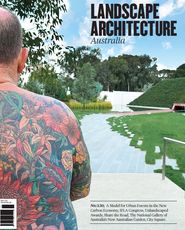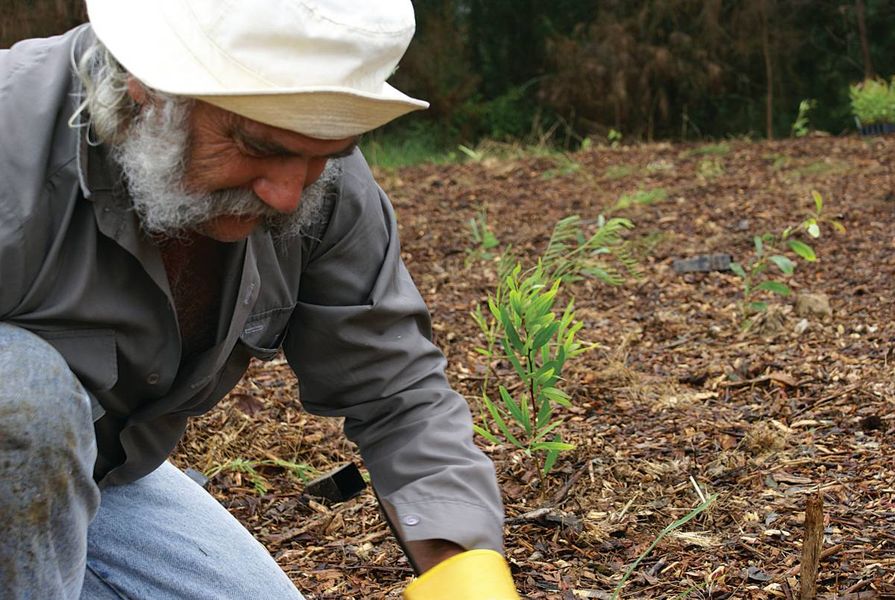The Regenesis Project is an urban-rural reafforestation program to establish native carbon offset forests throughout the Blacktown City Council area in western Sydney and the Liverpool Plains Shire Council area in the rural north-west slopes of New South Wales. In 2007 the project set up a model for public and private landowners to grow native revegetation areas and generate an income from them through the new carbon economy. The lessons learnt since then offer key insights on the establishment of forests in the low-density urban areas and rural settlements of Australia. Equally, they demonstrate the potential scale of change in our cities and settlements both resulting from, and necessary for, a dynamic carbon economy.

A local farmer cultivates his marginal land in preparation for the establishment of his carbon forest.
The path to climate-neutral cities involves three linked strategies. The first is to substantially reduce energy use. The second is to adopt alternative, low-carbon-emitting energy production methods such as solar and wind, while the final strategy is to offset remaining emissions. This can be achieved through purchasing carbon offset certificates via carbon trading schemes. Carbon trading allows industries that cannot economically reduce CO2 emissions to buy credits from industries that have reduced their emissions more than the level required. In voluntary markets there is a wide range of carbon offsets that can be pursued, ranging from easy carbon savings such as insulation measures to increasingly higher hanging fruit such as reafforestation projects. Carbon offset forests are a significant part of the carbon mitigation portfolio.
The first steps in establishing a carbon offset forest are critical to ensure compliance with Australian standards, which themselves respond to the international Kyoto Protocol. Land that the forests are established upon needs to be “Kyoto compliant” in Australian terms, which includes having a surface area greater than two thousand square metres while being predominantly deforested as of 31 December 1989. Forests need to be planted on or after 1 January 1990, with the proposed canopy structure at least two metres high at maturity while covering at least 20 percent of the proposed forest site.
The first step for Regenesis project leader Matthew O’Connor and his Regenesis team was to map all the Kyoto Protocol-compliant land and then carefully select sites to establish “test” forests within this “Kyoto footprint.” The mapping immediately revealed the scale of change possible within the area and the potential for Blacktown to be a very green city. It also emphasized that carbon offset forests need to involve all parts of the society, due to the mosaic of public and private ownership patterns that make up the mapped areas. In the Liverpool Plains Shire ten of the resulting forests are privately owned, one is council owned and one is crown land. In Blacktown City Council, twenty-one of the Regenesis carbon forests are council owned and one is on crown land. The local urban and rural communities were engaged in planting the many trees on public and private land. The project has been a great awareness and knowledge generator within both communities – not just on the carbon economy but also on the landscapes and ecologies of the local areas. Carbon certificates generated through reforestation projects are currently being sold by Australian landowners through the voluntary carbon market. The Regenesis Project demonstrates to landowners that the way into the carbon economy can be much simpler than expected. As one participant said, “At first I thought there was all this complex legal stuff. But once it was explained to us it was easy to understand. It’s a wonderful grassroots project.”
The Blacktown Local Government Area is in many ways an ideal location for testing the establishment of carbon offset forests in metropolitan areas. A peripheral suburb of Sydney, Blacktown’s low-density pattern of land use is similar to many cities around Australia and in the developed world, with fragmented and patchy land use and overlooked open-space resources. Areas adjacent to sports fields, old quarries, buffer zones between infrastructures and riparian corridors all offer open-space resources with the ability to generate green capital. Most Australian cities exist in deforested environments, making the re-establishment of forests in their metropolitan areas not only highly desirable but eminently possible. Before the current political uncertainty surrounding the carbon economy in Australia, analysis by the Australian Bureau of Agricultural and Resource Economics suggested that a carbon price could increase the area of agricultural land used for timber plantations by up to 4.5 million hectares, while the area of environmental plantings could increase to 21.8 million hectares by 2050.
While there is ample space for carbon offset forests in our cities, they need to be integral to the design of our cities for reasons beyond carbon capture. While the use of native species is not a “Kyoto requirement,” a primary objective of Regenesis was to utilize local provenance species in the establishment of these carbon-compliant forests in order to strengthen and enhance the critically endangered vegetation communities of western Sydney and the Liverpool Plains. Forests also reduce the emissions of CO2 from urban areas by providing shade and climate control functions, therefore significantly reducing the need for heating and cooling within cities. Trees have been shown to preserve the life of built surfaces by sheltering them from harsh solar rays as well as providing a large surface area to remove dust and pollutants from the air. They also make important contributions to the hydrology, biodiversity, soils and recreational spaces of our cities. These additional benefits are worth emphasizing, not only for reasons of urban design but because those buying carbon certificates are often willing to pay higher prices when certificates are generated from forests providing biodiversity benefits, as provided by the Regenesis model. Buyers on the voluntary carbon market purchase carbon certificates to offset their carbon emissions because they wish to, not because it is mandatory. Urban forestry projects are a lot more visible than projects destroying noxious greenhouse gases in a Chinese factory, for example. Extension of wildlife habitat is particularly attractive to buyers.
In Australia, the Kyoto Protocol requirement for “permanent” carbon sequestration has generally been interpreted as protecting the carbon forests for one hundred years. Like climate-neutral cities, biodiversity is a long-term project, making the two ideal partners in new green carbon offset frameworks for cities and their precincts such as Blacktown. This long-term legacy is the most exciting part of the project and will form a durable green structure for the city of Blacktown. The carbon economy has the potential to shift planning decisions about our city into long-term perspectives necessary for ecological systems to really take hold. Carbon offset forests are green structures planted by the communities of today for generations to come.
Source

Discussion
Published online: 24 Sep 2011
Words:
Scott Hawken
Issue
Landscape Architecture Australia, May 2011





















